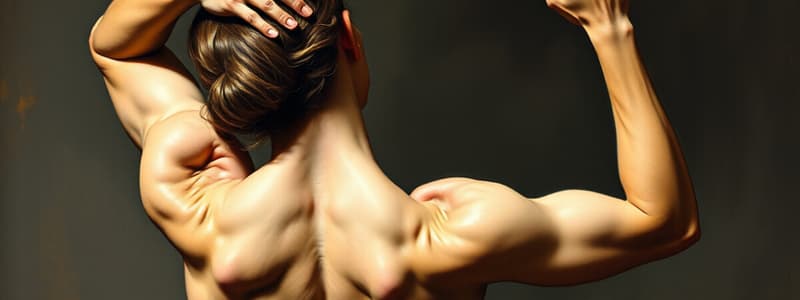Podcast
Questions and Answers
What is the only bony articulation of the shoulder girdle with the axial skeleton?
What is the only bony articulation of the shoulder girdle with the axial skeleton?
Sternoclavicular joint (SC joint)
What type of joint is the Glenohumeral joint?
What type of joint is the Glenohumeral joint?
- Saddle joint
- Plane joint
- Hinge joint
- Ball and socket joint (correct)
The ______________ is a fibrocartilaginous lip that deepens the fossa to increase joint congruity.
The ______________ is a fibrocartilaginous lip that deepens the fossa to increase joint congruity.
glenoid labrum
What provides dynamic stability to the Glenohumeral joint?
What provides dynamic stability to the Glenohumeral joint?
The Acromioclavicular joint is a ball and socket joint.
The Acromioclavicular joint is a ball and socket joint.
Which ligaments support the Sternoclavicular joint?
Which ligaments support the Sternoclavicular joint?
Motions of the scapula include ____, _____, ____, and _____ rotation.
Motions of the scapula include ____, _____, ____, and _____ rotation.
What is the primary function of the upper trapezius, serratus anterior, and rhomboids?
What is the primary function of the upper trapezius, serratus anterior, and rhomboids?
What role does the long head of biceps play in shoulder stability?
What role does the long head of biceps play in shoulder stability?
Flashcards are hidden until you start studying
Study Notes
Structure and Function of the Shoulder Girdle
- Only one bony articulation exists between the shoulder girdle and axial skeleton at the sternoclavicular joint.
- The clavicle's connection to the sternum leads to a reduced articular contact area, enhancing upper extremity mobility.
- Stability is maintained through a balance of scapular and glenohumeral muscles as well as soft tissue structures.
Shoulder Complex Joints
-
Glenohumeral Joint (GH Joint)
- A ball-and-socket synovial joint supported by rotator cuff tendons (SITS).
- Glenoid fossa is a concave area on the scapula, providing minimal stability.
- Glenoid labrum deepens the fossa for better joint congruity and serves as a capsule attachment site.
- Humeral head contacts and moves within the fossa, allowing significant movement but potential for instability.
- Dynamic stability is achieved through rotator cuff muscle contraction, tightening static restraints.
-
Acromioclavicular Joint (AC Joint)
- A plane synovial joint with weak capsules reinforced by superior and inferior AC ligaments.
- The joint allows movements like upward and downward rotation of the scapula.
- Stability is aided by the strong coracoclavicular ligament.
-
Sternoclavicular Joint (SC Joint)
- Saddle type synovial joint functioning similarly to a ball-and-socket joint.
- Supported by anterior and posterior SC ligaments, interclavicular ligaments, and costoclavicular ligaments.
- Medial end of the clavicle is convex in shape, facilitating a range of movements related to scapular motions.
Arthrokinematics of Shoulder Joints
- Glenohumeral joint follows the convex-concave theory: humeral head rolls in the same direction while sliding in the opposite direction on the glenoid fossa.
- Scapular motions affect SC joint movements, which include elevation, depression, and rotational adjustments.
Functional Articulations
- Scapulothoracic Articulation
- Allows scapular motions: elevation, depression, protraction, retraction, and rotations.
- Stabilization during arm movements is crucial to maintaining scapular position.
Scapular Stability
- In a dependent position, scapular stability depends on a balance of forces, primarily from muscle support against the weight of the arm.
- Active arm movements engage scapular muscles which stabilize and control scapular positioning.
- Effective muscle function relies on the scapula's position, with muscles like the upper and lower trapezius and serratus anterior working together during arm elevation.
Studying That Suits You
Use AI to generate personalized quizzes and flashcards to suit your learning preferences.




